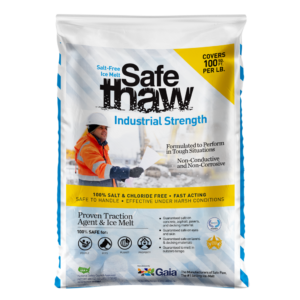What’s Better Than Salt To Deice?

If you live in a cold climate, you know winter is the season of slippery sidewalks and treacherous driveways. Traction agents and chemical-free ice melt are effective alternatives to salt because they won’t harm your pets or property. In this article, we will discuss tips for walking on ice and how to deice safely.
- Salt is messy because it makes white marks on your sidewalk, driveway, and deck—and those white marks are hard to clean up.
- Salt is corrosive because when it gets wet, it turns into an acid that can eat away at concrete surfaces (and other materials). It also reacts with aluminum components of vehicles such as wheels or frames.
- Salt can damage your shoes because its granules are rough on the surface of the sole. They can even break off pieces of rubber soles if they’re not protected by steel toe caps. This will make them less comfortable walking around in cold weather conditions during the winter months.
Traction Agent:
A non-melt traction agent product like Walk On Ice provides quick traction. The tiny spiky granules bite through the ice’s surface while absorbers soak up the surface water that causes the ice to be slick. When you spread it, you instantly have a safe walking surface. It also outperforms rock salt and traditional ice melt because it is non-toxic to humans, pets, and the environment. You need not to worry about how thick should ice be to walk on. Walk on ice is made of micronutrients. They allow the product to be swept into the lawn or garden for greener grass and a lush garden in the spring.
Get ready for winter with Walk On Ice instant traction on snow and ice
Snow Melting Mats:
Snow melting mats, like outdoor rugs, are designed to be placed in high-traffic areas to help remove snow, sleet, and ice. Embedded wiring and heating coils, for example, are utilized to warm up the mat and melt away the surrounding snow. They are small and consume electricity, and require an active power source. During the winter, this entails a larger energy cost.
Electric Or Gas-Powered Snow Blowers:
These are only suitable for smaller properties and shared areas, but they can assist remove snow from walkways and drives. One significant disadvantage is that they do not operate well with ice or extensive stretches of icy ground, so keep that in mind.
Kitty litter:
Cat litter is typically more expensive than rock salt in most places, making it unsuitable for large-scale applications. The most serious problem with cat litter is that it can cause a mess once the snow melts, especially after the winter months are over.
Conclusion
So if you’re wondering how thick should ice be to walk on or looking for a better way to keep your sidewalks and driveways clear this winter, consider switching to a traction agent. It’s effective at low temperatures and won’t harm your pets or shoes. Plus, it’s much easier to use than traditional ice melt products.
Other Ice Melt Products
Safe Paw
The Original and #1 Selling Pet and Child Safe Ice Melt for over 20 years. Guaranteed environmentally safe – will not harm waterways and sensitive wetlands. All products are made in the USA.

Safe Thaw
Imagine an ice melt you can put down and never worry about. It won’t harm pets, kids, and your property. That’s Safe Thaw. Unlike anything else on the market, Safe Thaw can change how winter affects our planet.



